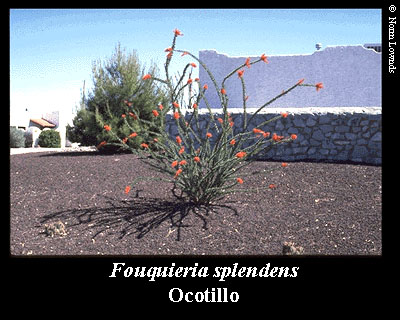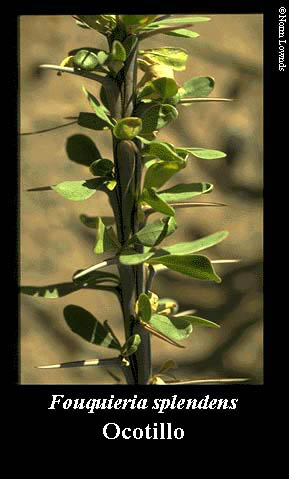Ocotillo
Fouquieria Splendens



Laurie Ortiz, Agro / Hort 100G Spring 2002
Family: Fouquieriaceae
Ocotillo is a drought-deciduous shrub. It can have anywhere from 6 to 100 wand-like branches that grow from the root crown. It's stems can grow anywhere from 9 to 30 feet tall with spines to 1.5 inches long. Leaves are thick and leathery and can grow out several times in a growing season depending on the amount of water available in a season. Ocotillo is usually found in AZ, NM, CA, CO, TX and Mexico where soil is well-drained on rocky slopes, mesas, out washed plains and desert grasslands.
City slickers like it because it adds grace to their desert landscape and it does not take a lot of water once established. It can be planted it full sun. Propagation is easy by cuttings or seeds. But let us not forget the beautiful fire orange flowers it produces. These flowers produce a honey-like nectar that attracts Hummingbirds.
Ocotillo is available at most nurseries as bare root. It can be planted at any time of the year. So next time your out riding in the desert and you suddenly see fire orange color appear from a brush most likely it will be the ocotillo.
The Fouquieria, also known as the Ocotillo, Coachwhip, or Candlewood, is endemic to Mexico and the Southwestern United States. Fouquieriasreside mainly in desert habitat. Some Fouquieria are trees with erect, stout, branched trunks. Others are much-branched shrubs, and the Ocotillogroup consists of shrubs with erect or leaning, mostly branchless, wandlike stems. The blades of the leaves fall early, leaving the stalks to develop as thorns from which the axils will sprout secondary leaves.
Fouquieria slendens posses showy flowers which make attractive displays. This is one reason why this is the only species of Fouquieriamuch cultivated. From the base it produces several to many erect or leaning canes from 6 to 20 feet, but more commonly about 6 to 10 feet. In warm desert regions the ocotillo is a favorite garden shrub. It is used to provide grace and variety to landscapes. It is much used as an impenetrable hedge plant. One thing to be cautious about when planting the ocotillo is that they can be dangerous, perhaps for children considering the amount of stout thorns which exist throughout the plant.
In the desert the ocotillo can stand leafless for many rainless months. During that time, although the roots are deep, obtain little or no water. This is possible because of the plants' ability to conserve moisture. The ocotillo does not store a lot of water either, it simply is very careful with the little supplies it obtains. Another interesting fact about the ocotillo is that it is the most cold-resistant species.
-Chris Case Agro / Hort 100, Spring 1999